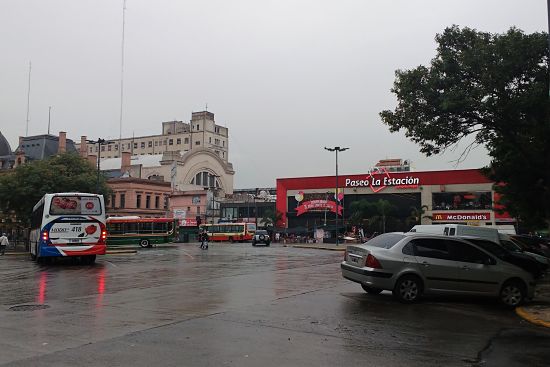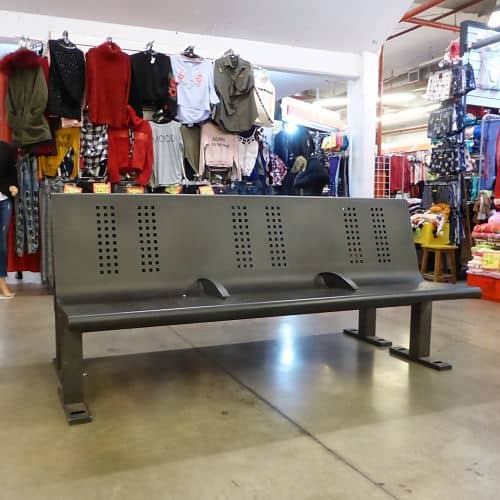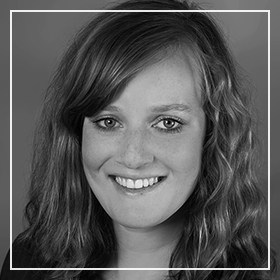In a situation of displacement, migrants and Argentinians forge social relations and thereby emplace themselves in a Buenos Aires shopping centre.
Doing research on mobility and displacement in Buenos Aires, I got to know some of my most important interlocutors while being rather immobile myself, sitting on a bench in the shopping centre Paseo La Estación. The Paseo, a two-storey building directly opposite the most frequented train station of Buenos Aires city, offers a broad range of cheap shops run mostly by Latin American and African migrants, as well as seating for shoppers and passers-by who use the shopping centre as a shortcut to reach the bus stations at its rear. I sat down on a simple, dark grey metal bench with three seats to each side (see image above). Instead of being a point of observation that would enable me to quietly take note of what was going on in this shopping centre, the bench turned out to be a socializing hub where I could hardly stay without getting involved. The stories of Luz, Malena and Julio [1], who got to know each other on the bench, shed light on the ways social relations emerge in a place of transit and among people struggling to find a place in the city of Buenos Aires.
Luz (42) followed her older sister Elizabeth from Peru to Argentina in 2000. Like many other migrants from Latin American and African countries she worked as a street vendor, until the birth of her son Rafael in 2007. Around this time, she started to sell mobile phones, headphones, USB sticks and other PC accessories. She still worked as a mobile vendor, constantly moving around with her baby but realized that she longed for a job that was ‘más sedentario’ (more sedentary) for the sake of her baby boy. ‘I was selling mobile phones, and this made me kind of afraid. Because the people who sell mobile phones … get robbed, get attacked’, she stated. ‘It was not for me but for Rafael. And as he was little, and because of the cold, and everything.’ In addition, street selling has become more challenging in Buenos Aires since the beginning of the 2000s because of the increased police persecution of street vendors (Pita et al. 2017). This has made many former street vendors like Luz opt for renting a fixed shop. Luz took over a clothes shop, formerly rented by Elizabeth, in the Paseo, established a successful business and was able to open up three other shops in the same locality, one of which she gave back to her older sister in 2017. By 2018, Luz, Elisabeth and two other sisters who had all grown up in Lima, Peru, worked in the shopping centre as shop tenants or vendors. One of Luz’ stores stood directly next to the bench.
Malena (40) had already been frequenting the shopping centre and the bench regularly for a while before Luz started to talk to her in early 2017. But Luz had noted Malena’s presence before, thinking that she was a prostitute. In fact, sex workers and potential clients used to frequent the bench to establish contacts, but Malena was not one of them. Malena lived in a women’s shelter in the Constitución neighbourhood one block away from the shopping centre and had to pass the time between 8 a.m. and 6 p.m. when the shelter was closed. During this time, its inhabitants had to find other places to spend their time. Malena, like many others, liked to hang out in the Paseo la Estación.
When I got to know Luz and Malena in March 2018, Malena had moved to a shelter in another part of the city but still used to come to Constitución almost on a daily basis. Here, Luz and Malena shared a mate or a coffee with the hot water from a water dispenser in Luz’ store and chatted. Luz sometimes invited Malena to spend the night in her apartment. Both of them enjoyed this, because Malena could relax better in Luz’ apartment than in the women’s shelter, and Luz enjoyed Malena’s company. From time to time, Malena cleaned Luz’ apartment and, occasionally, she helped Luz transport goods from the wholesale market. When Malena did not turn up for a reason unknown to Luz, she would mutter worriedly: ‘Malena has not come yet. Where is she?’ Luz cared a lot about her bench acquaintances; she told me that she always started to worry when she did not see a person for a while, and Malena in particular. She had become very used to and fond of her presence.

Malena had come to Buenos Aires from the province of Corrientes in the 1990s. She had family in Corrientes and two brothers somewhere on the outskirts of Buenos Aires, but she had broken with her family for reasons unknown even to Luz. She did not speak to anyone about how she had ended up living in a shelter. What she did speak about was how much she liked coming to this shopping centre. She had spent a while in a shelter in Microcentro, the city centre, and had been forced to hang out in the Microcentro neighbourhood while waiting for the shelter to open again at night. But she had not liked it. ‘I felt like this was not mi lugar (my place)’, she explained. And she added: ‘En Microcentro, no quiero estar. I don’t want to be in Microcentro. I stay there for one hour and already want to leave.’ Her feeling of being in the right or the wrong place was linked directly to the people she found herself surrounded by. ‘There [in Microcentro] are more tourists, the more snobbish people go there. … People with money.’ Here in the Paseo, by contrast, people were ‘más humilde’ (humbler), as my interlocutors used to say. In the Paseo, Malena knew Luz and her sisters, as well as many others who used to come by regularly and chat for a while. Here, she visibly felt ‘in her place’; she went in and out of Luz’ shop to prepare her mate, took a stool from Luz’ store that she always placed at the bottom of the stairs opposite the bench, a position that enabled her to observe Luz’ shop and the bench, but without being in the way of the passers-by. She greeted those she knew, chatted, laughed a lot, and sometimes she sang a song.
Similar to other shelter inhabitants whom I got to know in the shopping centre, Malena differentiated between people ‘en situación de calle’, homeless people literally living on the street, and herself, who did not have a flat but did not live on the street. However, her situation was not far away from being on the street, she admitted. In the shelter, each inhabitant had to register and stick to certain rules of behaviour, such as not fighting with others and always leaving a notice when one would not turn up, so that another person in need could take the free sleeping place. Those who violated the rules could be thrown out: ‘If they throw you out there, you are en la calle (on the street). And after the street, there is nothing more to come.’

La calle was not only feared by those who were close to living on it. Constitución is considered a problematic part of town, not only by the city government, the police and the journalists who regularly report on the drug dealing, prostitution and robbery in the district, but also by many inhabitants and those who do not live there but work or spend their time in the shopping centre. Within surroundings perceived to be dangerous by many, the shopping centre was a comparatively safe and quiet place to stroll around, sit and relax. This was why Julio, a man in his late sixties, had started to frequent the Paseo. Julio lived in Berazategui in southern Buenos Aires province and worked several days a week as a car-park attendant on a golf-course in La Plata on an irregular basis, i.e. without a contract or insurance. He had done this work for more than 20 years, but even before that, he had hardly ever been employed on a regular basis. When he had some spare time, he frequented Constitución, where the train from La Plata and Berazategui ended. He enjoyed being in the Paseo, where he sat on different benches, including the one in front of Luz’ store, and chatted to different people who worked there and who had got used to him dropping in regularly. He brought newspapers he had collected elsewhere and that were thankfully received by Luz and Malena, who would then lean over them and discuss the latest news.
Julio talked to Malena and Luz, as well as to complete strangers sitting on the bench as long as they inspired his confidence. Very often, his conversations with strangers were exchanges about how dangerous the city was, what crimes had been reported lately on television and the tricks thieves would apply to rob people in the street. This was certainly a topic that strangers could talk about easily because many followed the dramatic crime reports delivered on television. However, I noticed after a while that Julio was really afraid of being en la calle. Julio suffered from problems with one of his knees and used a walking stick that was too short for him, which made him appear more crooked than he needed to be. His crooked walking made him feel even more insecure, because he did not see everything well enough and felt that he appeared an easy and feeble victim. Apparently, he had observed how others had been robbed and had experienced being robbed himself. At the same time, he did not want to stay at home when he did not work, because he liked being outside and felt lonely. He had split up from his wife and almost never saw his youngest daughter who continued living with her mother and her mother’s new partner. He was sharing an apartment with his eldest daughter, but she worked night shifts and so he never saw her either. Julio wanted to go out and to talk to people. For him, the Paseo was a place where he felt safe, could have conversations and had established relationships with people with whom he got on well.
Luz, a Peruvian migrant who had established her own business in Constitución, Malena, one of many inhabitants of the shelters for homeless people nearby, Julio and other elderly, sometimes retired people, sex workers and their clients and, of course, passers-by who wanted to take a rest from their shopping activities sat on the bench and contacted each other in mostly fleeting encounters that sometimes ended up in long-lasting relationships. Many of them, including the three examples developed above, have experienced displacement through (border-crossing) migration, mobile and precarious working conditions, the daily, intermittent deprivation of a place, the lurking danger of a permanent life on the street or the fearful perception of formerly familiar surroundings (Bjarnesen & Vigh 2016: 10) that make them feel out of place.
Displacement, in this broad sense, includes mobility as well as other forms of dispossession that affect ‘migrant’ and ‘non-migrant’ city residents in contexts of neoliberal urban restructuring (Glick Schiller & Çağlar 2013, 2016).
At the same time, these persons struggle actively to create better working conditions and supportive social networks within the opportunities and constraints of their city context (ibid.). Relating to each other forms part of their struggle to recreate a social place, to emplace themselves. They make use of fixed materialities, such as the bench, that offer possibilities of situating and bringing people together.
For Marc Augé, a shopping centre is a socially and historically empty non-place that ‘creates neither singular identity nor relations’ (Augé 1995: 103), typical for supermodern urbanities. Where, if not in such a non-place and site of transit would one expect people to experience displacement? However, for Luz, Malena, Julio and many others, the Paseo is the exact opposite: a meaningful point of networking, relating, and thus emplacement. In the Paseo, they create a social environment that makes it for many, as Malena put it, a place where they like to pass time, in a city in which their presence is often contested.
Bibliography
Augé, Marc, 1995: Non-Places. Introduction to an Anthropology of Supermodernity. London, New York: Verso.
Glick Schiller, Nina and Ayşe Çağlar, 2013: Locating migrant pathways of economic emplacement: Thinking beyond the ethnic lens. Ethnicities 13, 494-514.
Glick Schiller, Nina and Ayşe Çağlar, 2016: Displacement, emplacement and migrant newcomers: Rethinking urban sociabilities within multiscalar power. Identities 23, 17-34.
Pita, María Victoria, Joaquín Santiago Gómez and Mariano Skliar, 2017: Historias mínimas. Apuntes para una etnografía del control contravencional y la gestión de ilegalismos an la Ciudad de Buenos Aires. In: María Victoria Pita and María Inés Pacecca (eds.): Territorios de control policial. Gestión de ilegalismos en la Ciudad de Buenos Aires. Buenos Aires: Editorial de la Facultad de Filosofía y Letras UBA, 77-146.
Vigh, Henrik and Jesper Bjarnesen, 2016: Introduction: The Dialectics of Displacement and Emplacement. Conflict and Society 2, 9-15.
[1] All individuals’ names have been changed.





